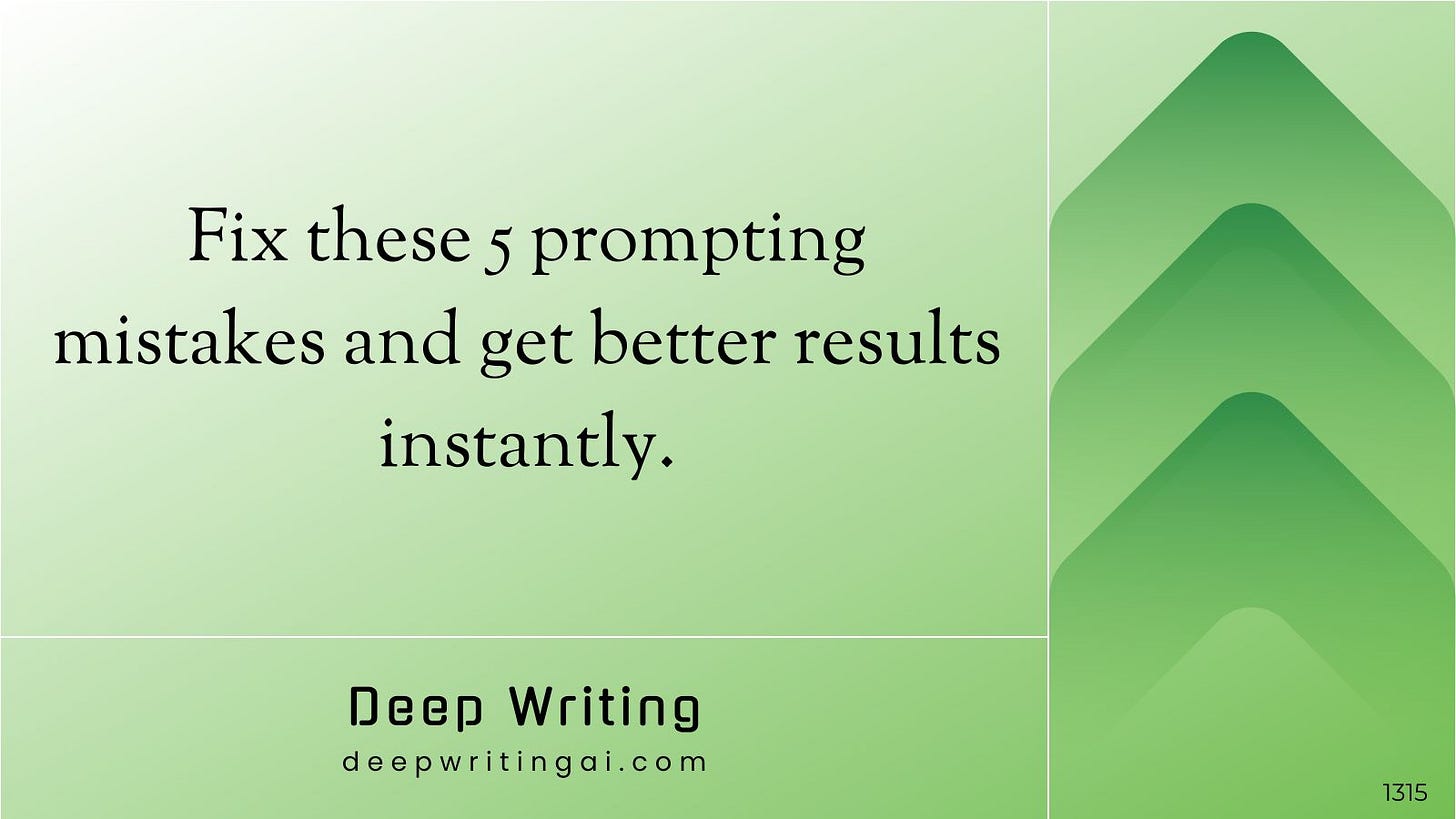The 5 Prompting Mistakes Killing Your AI Content
... and how to fix them
It’s you against a prompt box.
You type in your request, and hit send. What comes back is... disappointing.
I’ve seen even experienced AI users make these 5 mistakes that kill productivity and waste time.
In this article, I’ll provide straightforward fixes you can apply immediately.
Let’s begin!
1. Not specifying the target audience and their knowledge level
When your prompt lacks specificity, the AI makes random assumptions about your audience, their knowledge level, and what information would be valuable to them.
Answer these two questions:
Who are we writing for?
What do they know?
Bad prompt
Write a blog post about automating content systems using AI.Better prompt
Write a 1,200-word blog post about automating content systems for solopreneurs who want to scale their business using AI.
Assume they understand the basics of AI but don't know how to use it to automate their workflow.2. Not specifying what the goal of the article is
To build authority online, every piece of writing must address a pain point the ideal reader has, and make their life tangibly better.
What’s the pain point we’re solving?
What’s the promise we’re making to the reader?
Bad prompt
Write an article about coming up with content ideas using AI.Better prompt
Write a 1200-word article about coming up with content ideas using AI.
Here are the required details:
1. Target audience: Solopreneurs looking to build authority online through written content.
2. Knowledge level: They understand the basics of AI but don't know how to use it to automate their workflow.
3. Pain point resolved: Every week, they're faced with the same dilemma: what should we write about?
4. Promise made: The article should give them a practical system to automatically come up with content ideas using AI. The reader should be able to implement this system within a week and using free tools.3. Using the same model for different tasks
Different models excel at different tasks.
Reasoning models (like ChatGPT’s o3/Claude Extended Thinking) help you think deeply about a problem and break it down to smaller sub-problems. Use these models when you have a rough idea of an article and need help brainstorming.
Research models (like ChatGPT’s DeepResearch) excel at researching a topic. Use these when you have an idea of the topic you want to write about, and want to conduct an in-depth research.
Regular models (like Claude/4o) perform better at normal writing tasks. Once you know the topic you want to write about, and have the related research, provide them to a regular model and ask it to write for you.
4. Jamming too many tasks in one prompt
Cramming multiple content elements into a single prompt creates the “mile-wide, inch-deep” problem.
Don’t throw the kitchen sink at the AI. Break big tasks into smaller sub-tasks.
Let’s say you want to create an article on the common prompting mistakes people make while creating content with AI.
Don’t ask the AI to
Write a 1200-word article about the common prompting mistakes people make while creating content using AI.Instead
Break the task down to individual components, and use separate chat sessions:
Task #1: Research the common mistakes people use while using AI to create content
I need to write an article about common prompting mistakes people make when creating content with AI.
Research and identify the 5-7 most critical mistakes that impact content quality. Understand the industry best practices and the latest research. For each mistake, explain its negative impact on the resulting content and how to fix it.Task #2: Write the article tailored to your audience. Include the research in the earlier step as part of the prompt.
Write a 1200-word article about the common prompting mistakes people make when creating content with AI.
Here are the required details:
1. Target audience: Solopreneurs looking to build authority online through written content.
2. Knowledge level: They understand the basics of AI but are not aware of the prompting best-practices.
3. Pain point resolved: New users often struggle with getting useful answers from AI because they don’t know how to ask effectively.
4. Promise made: Instead of feeling that an AI reply is a hit-or-miss surprise, they’ll feel more in control and capable of steering the conversation.
5. Research: Here's the research conducted on the topicTask #3: Edit the article to sound like you.
Here's an article draft on the common prompting mistakes people make when creating content with AI.
Edit this article draft to match my unique voice. Ensure that it follows the style guide to the point.
Here's the style guide:
[Insert your style guide]Here’s how you can create your brand’s style guide.
Perform each of these tasks in separate chat sessions, and choose the appropriate model for each.
5. Starting from a blank screen
It drains energy to craft a prompt from the scratch every single time. Instead, start with a pre-made prompt and tweak as per the requirements.
Use this master prompt to generate the starting prompt
Give it the information we discussed in points #1 and #2
Check if the prompt contains all the necessary details. Tweak as required.




Thank you so much. GREATTTTT
So practical! Great advice